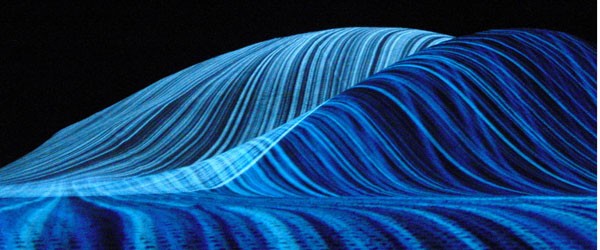Projection on forms and spaces

Theoretical background
One of the interesting differences between film and video projection is the depth of field. While film projection has a very narrow depth of field, video projection has an almost endless depth of field, so both foreground and background can be sharp at the same time. This makes it possible to project on objects/forms at various depths using the same video projector. The masterclass will explore how one projector can be used to project on several surfaces simultaneously, by dividing, in software, the projected image into several smaller images. This technique allows for instance to project on three sides of a cube using one projector, with the illusion of it coming from three different sources. When projections match the objects/surfaces they project upon, the physical forms appear to get a second "skin", either of solid color, image or video. The objects get a projected texture. By coupling this method with multihead splitting devices (e.g. Matrox dual or triplehead2go), one computer can generate visuals for 2 or 3 projectors flooding many surfaces in space.
Mapping (based on creating a virtual 3-D model of the objects/forms you want to project onto) is one of the usual approach for projecting on surfaces in space. This technique usually needs time-consuming calibrations and requires 3d rendering steps which makes it difficult to use for any realtime situation. The masterclass will explore a more flexible approach based on masking, where we work with multiple flat layers which mask individual surfaces of a form, but which are positioned, scaled and rotated in a 3d space.
Masking has many benefits when it comes to the actual process of making it, and the access to individual surfaces allows interesting video textures while giving full realtime control. Measurement or calibratation is no more needed: you place the projector and work with matching each layer to a different surface. 1
1Text based on HC Gilje research
Fin de l'appel à projets
20 mars
Workshop / Production Lab
9-15 avril
Exposition
16-17 avril
PAF
50 EUR
(lunch weekend + boissons inclues)
Masterclasse en anglais!
Lieu:
iMAL
30, Quai des Charbonnages/Koolmijnenkaai
1080 Bruxelles
BELGIUM
Infos complètes ici
Une archive : 1999-2010-2019
Cette page est une archive du site d'iMAL tel qu'il existait entre 2010 et 2019. Il documente activités et projets créés depuis 1999.
Pour notre actualité et nos activités plus récentes, veuillez vous rendre sur notre nouveau site https://imal.org
